
Orchidaceae, commonly called the orchid family, is a diverse and widespread family of flowering plants, with blooms that are often colourful and fragrant.

Cymbidium, commonly known as boat orchids, is a genus of evergreen flowering plants in the orchid family Orchidaceae. Orchids in this genus are epiphytic, lithophytic, terrestrial or rarely leafless saprophytic herbs usually with pseudobulbs. There are usually between three and twelve leaves arranged in two ranks on each pseudobulb or shoot and lasting for several years. From one to a large number of flowers are arranged on an unbranched flowering stem arising from the base of the pseudobulb. The sepals and petals are all free from and similar to each other. The labellum is significantly different from the other petals and the sepals and has three lobes. There are about fifty-five species and sixteen further natural hybrids occurring in the wild from tropical and subtropical Asia to Australia. Cymbidiums are well known in horticulture and many cultivars have been developed.

Oncidium, abbreviated as Onc. in the horticultural trade, is a genus that contains about 330 species of orchids from the subtribe Oncidiinae of the orchid family (Orchidaceae). As presently conceived, it is distributed across much of South America, Central America, Mexico and the West Indies, with one species (O. ensatum) extending into Florida. Common names for plants in this genus include dancing-lady orchid and golden shower orchid.

Trichocentrum, often abbreviated Trctm in horticulture, is a genus in the orchid family, Orchidaceae. Dancinglady orchid is a common name for plants in this genus. It was described by Stephan Ladislaus Endlicher and Eduard Friedrich Poeppig in 1836. This genus alone makes up the monogeneric Trichocentrum alliance, a quite distinct lineage of the subtribe Oncidiinae.

Cattleya is a genus of orchids from Costa Rica south to Argentina. The genus is abbreviated C in trade journals.
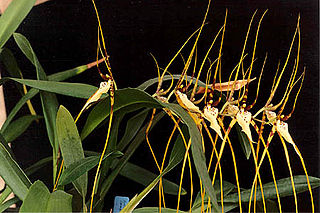
Brassia is a genus of orchids classified in the subtribe Oncidiinae. It is native to Mexico, Central America, the West Indies, and northern South America, with one species extending into Florida.

The Oncidiinae is a subtribe within the Orchidaceae that consists of a number of genera that are closely related.
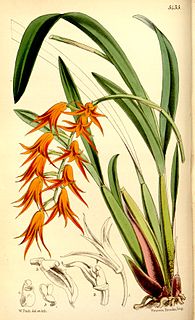
Ada, abbreviated as Ada in horticultural trade, is a genus of 16 species in the orchid family (Orchidaceae), subfamily Epidendroideae, tribe Cymbidieae, subtribe Oncidiinae, alliance Oncidium. The type species is Ada aurantiaca.

Miltonia, abbreviated Milt. in the horticultural trade, is an orchid genus comprising twelve epiphyte species and eight natural hybrids. The miltonias are exclusively inhabitants of Brazil, except for one species whose range extends from Brazil into the northeast of Argentina and the east of Paraguay.

Odontoglossum, first named in 1816 by Karl Sigismund Kunth, is a genus of about 100 orchids. The scientific name is derived from the Greek words odon (tooth) and glossa (tongue), referring to the two tooth-like calluses on the base of the lip. This genus of cool to cold growing orchids is to be found on open spots in the humid cloud forest at higher elevations from Central- and West South America to Guyana, with most species around the northern Andes. The abbreviation for this genus is Odm. in the horticultural trade.

Encyclia is a genus of orchids. The genus name comes from Greek enkykleomai, referring to the lateral lobes of the lip which encircle the column. It is abbreviated as E. in the horticultural trade.

Cyrtochiloides, a genus of orchids described in 2001 by Norris H. Williams and Mark W. Chase, is designed to provide a small group of Neotropical epiphytes, previously included under a broad concept of Oncidium Sw., with a new, more accurate identity based on DNA.

Tolumnia, is a genus in the family Orchidaceae. Previously known as the "equitant oncidiums," the species were segregated from the mega-genus Oncidium by Guido Braem in 1986. Dancing-lady orchid is a common name for some species in this genus.

Psychopsis is a genus of four known species of orchids native to northern South America, Central America and Trinidad. The genus name is abbreviated Pyp. in the horticultural trade.
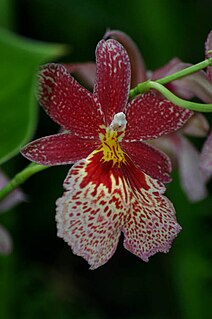
× Burrageara, abbreviated Burr. in the horticultural trade, is the nothogenus for intergeneric hybrids between the orchid genera Cochlioda, Miltonia, Odontoglossum and Oncidium. It was grown for the first time by the American Albert Burrage in 1927, and named after him.

Colmanara, abbreviated Colm. in the horticultural trade, is the nothogenus comprising intergeneric hybrids between the orchid genera Miltonia, Odontoglossum and Oncidium.
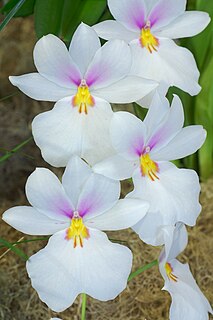
Miltoniopsis vexillaria is a species of epiphytic orchid in the genus Miltoniopsis.
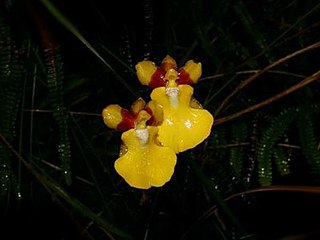
Otoglossum is a genus of flowering plants from the orchid family, Orchidaceae, native to South America and Central America.

Promenaea is a genus of flowering plants from the orchid family, Orchidaceae. It contains 18 currently accepted species, all endemic to Brazil.

× Oncostele, abbreviated Ons., is a hybrid genus of orchids, used for greges containing at least one ancestor species from the genera Oncidium (Onc.) and Rhynchostele (Rst.). The nothogenus was defined in 2003 by J. M. H. Shaw.

























